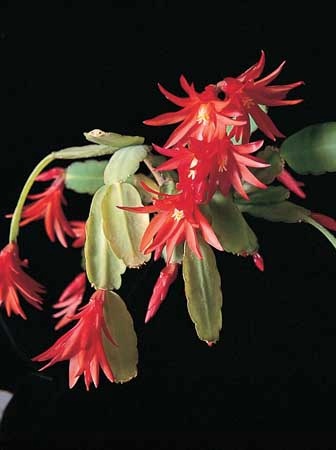cactus
plant
plural cacti, or cactuses
 flowering plants belonging to the family Cactaceae, of the order Caryophyllales. Botanists estimate that there are some 1,500 species, grouped into about 100 genera, but there is much argument about the limits of both genera and species.
flowering plants belonging to the family Cactaceae, of the order Caryophyllales. Botanists estimate that there are some 1,500 species, grouped into about 100 genera, but there is much argument about the limits of both genera and species.Cactaceae are native through most of the length of North and South America, from British Columbia and Alberta southward; the southernmost limit of their range extends far into Chile and Argentina. Mexico has the greatest number and variety of species. The only cacti possibly native to the Old World are members of the tropical genus Rhipsalis, occurring in East Africa, Madagascar, and Sri Lanka.
Cacti are succulent perennial plants. Although a few species inhabit tropical or subtropical areas, most live in and are well adapted to dry regions. Cacti generally have thick herbaceous or woody chlorophyll-containing stems. In most species leaves are either absent or greatly reduced, minimizing the amount of surface area from which water can be lost, and the stem has taken over the photosynthetic functions of the plant. Only the tropical genera Pereskia and Pereskopsis, both vines, have conventional-looking functional leaves, while the leaves of the Andean Maihuenia are rounded, not flattened. The root systems are generally thin, fibrous, and shallow, ranging widely to absorb superficial moisture.
Cacti vary greatly in size and general appearance, from buttonlike peyote (Lophophora) and low clumps of prickly pear (Opuntia) and hedgehog cactus (Echinocereus) to the upright columns of barrel cacti (Ferocactus and Echinocactus) and the imposing saguaro (Carnegiea gigantea). Most cacti grow in the ground, but several tropical species, including Epiphyllum, Rhipsalis, and Schlumbergera, are epiphytes (epiphyte), growing on other plants; others live on hard substrates such as rocks, while yet others climb far up trees. Epiphytic species tend to have thin, almost leaflike flattened stems. The appearance of the plant varies also according to whether the stem surface is smooth or ornamented with protruding tubercles, ridges, or grooves.
Cacti can be distinguished from other succulent plants by the presence of areoles, small cushionlike structures with hairs and, in almost all species, spines or barbed bristles (glochids). Areoles are modified branches, from which flowers, more branches, and leaves (when present) may grow.
The internal structure of cacti stems conforms to the pattern of broad-leaved angiosperms; a cambium layer of dividing cells, located between the woody inner tissues and those near the outside of the stem, is present. The bulk of the stem, however, consists of thin-walled storage cells that contain mucilaginous substances that prevent the loss of moisture. The stem of cacti is the main food-manufacturing and food-storage organ.
Several cacti develop plantlets at ground level that, as offsets, reproduce the species vegetatively. Tissues of cacti are broadly compatible so that terminal portions of one species may be grafted on top of another.
The primary method of reproduction, however, is by seeds. Flowers, often large and colourful, are usually solitary. All genera have a floral tube, often with many petal-like structures, and other less colourful and almost leaflike structures; the tube grows above a one-chambered ovary. A style topped by many pollen-receptive stigmas also arises from the top of the ovary. The fruit is usually a berry and contains many seeds. Soon after pollination, which may be effected by wind or by birds, the entire floral tube detaches from the top of the ovary to leave a prominent scar.
Cacti are widely cultivated as ornamentals. In addition, various species, notably prickly pears and chollas (both Opuntia), are cultivated as food. In South America species of Opuntia, Cereus, and others are used as living fences, and wood from columnar cacti is used as fuel in some desert regions. Barrel cacti (Echinocactus and Ferocactus) are a source of water in emergencies. Peyote, from Lophophora williamsii, has been used ceremonially since pre-Columbian times for its hallucinogenic properties.
- Saussure, Nicolas-Théodore de
- saussuritization
- Sautrāntika
- Sautuola, Marcelino de
- Sauveur, Albert
- Savage, Augusta
- Savage, Michael Joseph
- Savage, Richard
- Savai'i
- savanna
- Savannah
- Savannah River
- Savannakhét
- Savanna-la-Mar
- Savara
- Savard, Félix-Antoine
- Sava River
- Savarkar, Vinayak Damodar
- Savary, Anne-Jean-Marie-René, duc de Rovigo
- Sava, Saint
- savate
- Savelli, Luca
- Saverio Mercadante
- Savery, Thomas
- Savery, William